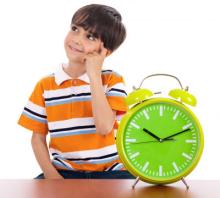
Temporal awareness is the development of an internal time structure that recognizes the relationship between movement and time. People are enabled to efficiently coordinate movements of the eyes and limbs with fully developed temporal awareness often referred to as eye-hand coordination and eye-foot coordination.1
Rhythm and sequence skills involve temporal awareness.2 Not only does developing a sense of timing and rhythm improve coordination and movement proficiency, but it also improves learning skills. Reading, writing, speech, and logical reasoning are all affected by temporal awareness involving sequence and rhythm.3 The ability to distinguish rhythms has been shown to improve the understanding of grammar and the ability to sort language into words and phrases. Adding body movements and dance to rhythms further enhances language skills.
To develop children’s temporal awareness an understanding of the rhythms of life, such as the repeating of the nature of the day with morning, afternoon, and night and the regular events of meal times, play times, and bed times allow them to create a frame of reference for the passage of time.4
Keeping a routine for young children is an important help for beginning temporal awareness. Clapping games and games that involve timing, taking turns, and following instructions sequentially develop temporal awareness. Swinging also gives a sense of timing and rhythm to the children.5
Movement skills that alternate slow, fast, and medium tempos help children distinguish differences in speed. Rhythm exercises of marching and walking to both regular and irregular beats improves children’s timing. Jumping rope and dancing are especially helpful in developing temporal awareness. Interception timing activities that allow children to predict when an object will arrive as in bouncing, catching, or hitting a ball takes time for them to be developmentally ready for the activity to be proficient. When achieved, the children have achieved the most advanced level of temporal awareness.6
- 1. Gallahue, David L. and Frances Cleland Donnelly. Developmental Physical Education for All Children. 4th ed. Champaign, IL: Human Kinetics. 2003. p. 116.
- 2. Frost, Joe L., Sue Wortham, and Stuart Reifel. Play and Child Development. Upper Saddle River, NJ: Prentice-Hall. 2001. p. 164.
- 3. Williams, Jane. “Temporal awareness. Helping your child to be a great learner: It’s all in the timing.” Active Babies Smart Kids. < http://activebabiessmartkids.com.au/artcles/great-learner-timing > 27 Sep. 2017.
- 4. Valency, Craig. “The Missing Link to Movement Mastery: Part 5 – Temporal Awareness.” SpiderFit Kids. < http://spiderfitkids.com/2015/04/16/the-missing-link-to-movement-mastery-part-5-temporal-awareness/ > 27 Sep. 2017.
- 5. Op. cit., Williams.
- 6. Op. cit., Valency.

